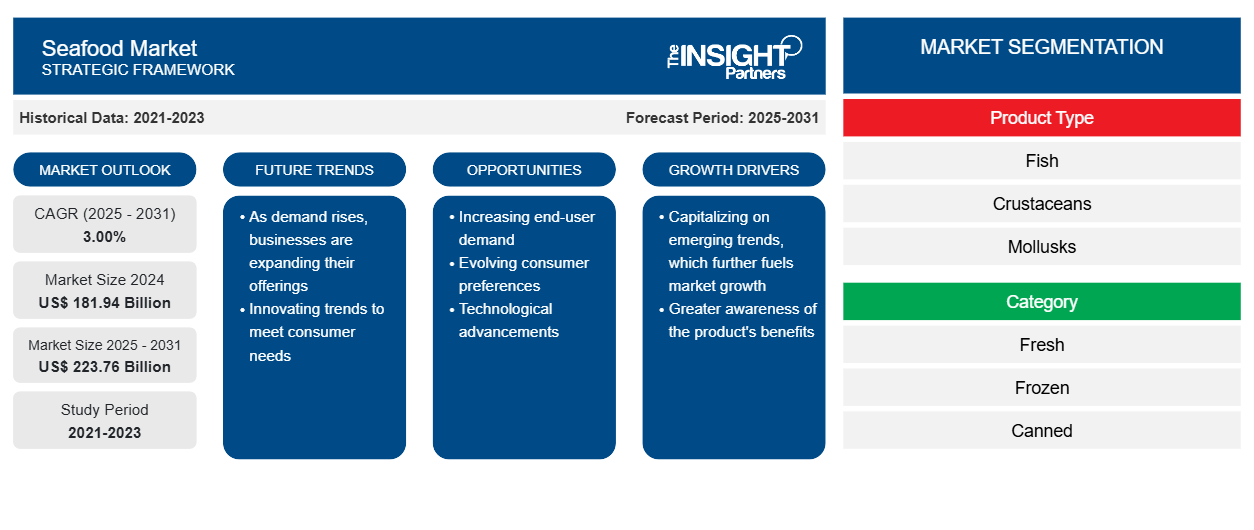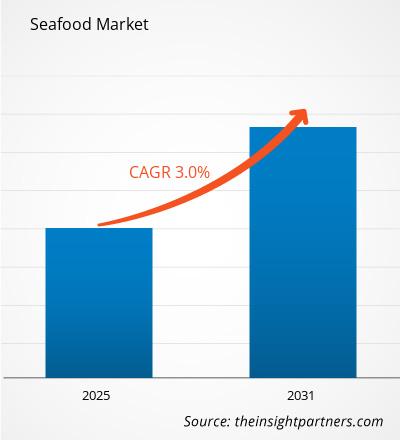The seafood market is expected to grow from US$ 1,71,493.93 million in 2022 to US$ 2,01,253.49 million by 2031; it is expected to grow at a CAGR of 3.0% from 2022 to 2031.
The Food and Drug Administration (FDA) stated that seafood encompasses all commercially obtained saltwater and freshwater fish, molluscan shellfish, and crustaceans. The demand for seafood is anticipated to witness dramatic growth across the globe owing to its health benefits. According to the Food and Agriculture Organization (FAO), by 2031, an additional value of 40 million tons of seafood, which is an increment of ~30%, will be required to meet the rising demand in the coming years. Also, the rising per capita consumption accompanied by the affluent nation's demand for imported seafood products is expected to support the market growth over the forecast period.
Asia Pacific held the largest share of the seafood market in 2021. Countries such as Japan, China, and South Korea have a traditional significance of fish in their cultures; hence, the high demand for fish in these countries is likely to fuel the growth of the seafood industry. In addition to fresh seafood, canned seafood is also highly embraced by the region’s population. For instance, tuna is highly popular among Asian people due to its appealing taste and ability to blend well with multiple flavors. Canned tuna products exhibit unique flavors from conventional ones that are penetrating the APAC market. Also, the enhanced distribution system with the growing e-commerce services is driving the seafood market growth.
Customize This Report To Suit Your Requirement
You will get customization on any report - free of charge - including parts of this report, or country-level analysis, Excel Data pack, as well as avail great offers and discounts for start-ups & universities
Seafood Market: Strategic Insights

- Get Top Key Market Trends of this report.This FREE sample will include data analysis, ranging from market trends to estimates and forecasts.
Customize This Report To Suit Your Requirement
You will get customization on any report - free of charge - including parts of this report, or country-level analysis, Excel Data pack, as well as avail great offers and discounts for start-ups & universities
Seafood Market: Strategic Insights

- Get Top Key Market Trends of this report.This FREE sample will include data analysis, ranging from market trends to estimates and forecasts.
Seafood Market Breakdown – by Region
- This FREE sample will include data analysis, ranging from market trends to estimates and forecasts.
Market Insights
Increased Demand for Frozen and Canned Seafood
With the proliferating demand for processed seafood, the market for frozen and canned seafood products is rapidly growing across the globe. Frozen seafood products are freeze processed, which aids in preventing the bacterial form of food products and increases their shelf life. Similarly, canned fish is processed and preserved in a sealed, airtight container such as an aluminum or tin can. Canned fish usually has a shelf life of 1-5 years. Canned seafood products are gaining immense traction among consumers owing to the rising demand for convenience foods. Similarly, frozen seafood is also positively embraced by the consumers, propelling the market growth. With the introduction of emerging technology, frozen seafood retains nutritional value and taste similar to fresh seafood. Freezing slows down the decaying process, thereby retaining its nutritional value. Fish frozen within a few hours of being caught contains well-preserved vitamins. It has been found that fresh fish is subject to rapid degradation and has a shorter shelf life. Hence, the rising need for convenience and increased shelf life offered by canned and frozen seafood products, coupled with increasing R&D activities by the major players, are driving the growth of the seafood market across the globe.
Product Type-Based Insights
Based on product type, the seafood market is segmented into fish, crustaceans, mollusks, and others. The crustaceans segment is projected to register the highest CAGR during the forecast period. Crustaceans are members of the subphylum Crustacea (phylum Arthropoda), a group of invertebrate animals comprising ~45,000 species across the world. The crustaceans group includes some commonly consumed seafood such as crab, shrimp, lobsters, prawns, crayfish, krill, and barnacles. They aid in weight loss, help in boosting immunity, and promote heat & brain health. Curried crab & dumplings, lobster newburg, potted shrimps, moeche, shrimp bisque, cereal prawns, and she-crab soups are a few of the most famous dishes prepared using crustaceans and are consumed all across the globe.
Distribution Channel Insights
Based on distribution, the seafood market is segmented into supermarkets and hypermarkets, specialty stores, online retail, and others. The supermarkets & hypermarkets segment held the largest share of the seafood market in 2021. Supermarkets and hypermarkets refer to self-help shops that offer a wide variety of products on sale. Seafood has a dedicated section in supermarkets and hypermarkets. Thus, the customers are provided with a wide variety of options, especially from the freezer section. Seafood counters of supermarkets and hypermarkets are considered excellent places to purchase a wide variety of fresh and frozen seafood. These factors are projected to drive the segment's growth.
Seafood Market, by Distribution Channel – 2022 and 2031


- This FREE sample will include data analysis, ranging from market trends to estimates and forecasts.


- This FREE sample will include data analysis, ranging from market trends to estimates and forecasts.
A few of the key players operating in the seafood market are American Seafoods Company LLC, Kangamiut Seafood A/C, Lee Fishing Company, Pacific American Fish Co. Inc., Royal Greenland A/S, Mowi ASA, The Union Group PCL, Grupo Nueva Pescanova, Trident Seafoods Corporation, and SeaPak Shrimp & Seafood Company. These players are engaged in developing products with reduced health risks to meet emerging consumer trends and abide by regulatory frameworks. They are involved in mergers and acquisitions, business expansions, and partnerships to expand their market share.
Report Spotlights
- Progressive industry trends in the seafood market to help players develop effective long-term strategies
- Business growth strategies adopted to secure growth in developed and developing markets
- Quantitative analysis of the seafood market from 2022 to 2031
- Estimation of global demand for seafood
- Porter's Five Forces analysis to illustrate the efficacy of buyers and suppliers operating in the industry
- Recent developments to understand the competitive market scenario
- Market trends and outlook, and factors governing the growth of the seafood market
- Assistance in the decision-making process by highlighting market strategies that underpin commercial interest, leading to the market growth
- Seafood market size at various nodes
- Detailed overview and segmentation of the market and the food & beverages industry dynamics
- Size of the growth in various regions with promising growth opportunities
Seafood Report Scope
| Report Attribute | Details |
|---|---|
| Market size in 2024 | US$ 181.94 Billion |
| Market Size by 2031 | US$ 223.76 Billion |
| Global CAGR (2025 - 2031) | 3.00% |
| Historical Data | 2021-2023 |
| Forecast period | 2025-2031 |
| Segments Covered |
By Product Type
|
| Regions and Countries Covered | North America
|
| Market leaders and key company profiles |
- Historical Analysis (2 Years), Base Year, Forecast (7 Years) with CAGR
- PEST and SWOT Analysis
- Market Size Value / Volume - Global, Regional, Country
- Industry and Competitive Landscape
- Excel Dataset



Report Coverage
Revenue forecast, Company Analysis, Industry landscape, Growth factors, and Trends

Segment Covered
Product Type, Category, and Distribution Channel

Regional Scope
North America, Europe, Asia Pacific, Middle East & Africa, South & Central America

Country Scope
Argentina, Australia, Brazil, Canada, China, France, Germany, India, Italy, Japan, Mexico, Russian Federation, Saudi Arabia, South Africa, South Korea, United Arab Emirates, United Kingdom, United States
Frequently Asked Questions
The major players operating in the global seafood market are American Seafoods Company LLC, Kangamiut Seafood A/C, Lee Fishing Company, Pacific American Fish Co. Inc., Royal Greenland A/S, Mowi ASA, The Union Group PCL, Grupo Nueva Pescanova, Trident Seafoods Corporation, SeaPak Shrimp & Seafood Company among many others.
In 2019, the Asia Pacific held the largest share of the global seafood market. Asia Pacific is a mature and well-established market for seafood. Countries such as Japan, China, and South Korea have a traditional significance of fish in their cultures, and hence, the high demand for fish in these countries is likely to fuel the growth of the seafood market. In addition to fresh seafood, canned seafood is also highly embraced by the region’s population. For instance, tuna is highly popular among the Asian people attributed to its appealing taste and ability to blend well with multiple flavors. The canned tuna products penetrating the Asian market are exhibiting unique flavors apart from the conventional ones. However, in recent years the canned tuna sales in the region have been declining due to the consumers swaying towards other seafood, particularly shellfish. Thus, the manufacturers have been innovating their products in terms of base ingredients that can attract consumers. However, in Australia, canned tuna sales are escalating.
The growth of the crustaceans type segment is primarily attributed to the fact as many species of crustaceans are found in freshwater, seawater and also in inland brines. The crustaceans group include some commonly consumed seafoods like crab, shrimp, lobsters, prawns, crayfish, krill and barnacles. These crustaceans develop form larvae and bear segmented, split limbs or appendages. The fisheries in many parts of the world capture prawns, shrimps, spiny lobsters and king crabs, especially from the Northern Pacific and its southern counterparts. Many species of true crabs like the blue crab, Dungeness crab and stone crab serves as a valuable source of food. Crustaceans are consumed as seafoods as they are loaded with lean proteins, micronutrients and healthy fats. They aid in weight loss, helps in boosting immunity and promotes heat & brain health.
Trends and growth analysis reports related to Food and Beverages : READ MORE..
The List of Companies - Global Seafood Market
- American Seafoods Company LLC
- Kangamiut Seafood A/C
- Lee Fishing Company
- Pacific American Fish Co. Inc.
- Royal Greenland A/S
- Mowi ASA
- The Union Group PCL
- Grupo Nueva Pescanova
- Trident Seafoods Corporation
- SeaPak Shrimp & Seafood Company

 Get Free Sample For
Get Free Sample For